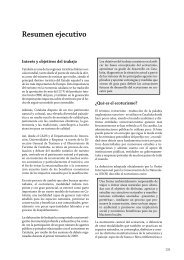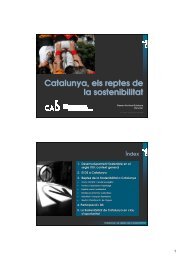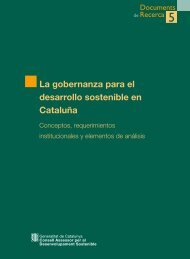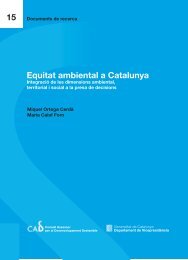4.4. The three main approaches to measuring and an<strong>al</strong>ysing sustainability are: (a)accounts (providing data); (b) narrative assessments not based on indicators;(c) indicator-based assessments. These approaches differ in their potenti<strong>al</strong> for:transparency (ease of <strong>de</strong>tecting v<strong>al</strong>ue judgements and construction of theassessment);consistency over time (comparability of successive assessments);participation (the more technic<strong>al</strong> the method, the less scope for participation);usefulness for <strong>de</strong>cision-making (clarity with which <strong>per</strong>formance and prioritiesare reve<strong>al</strong>ed).4.4.1. Accounts are constructions of raw data, converted to a common unit (suchas money, area or energy). Most cover highly important but sm<strong>al</strong>l aspects ofsustainability. Gener<strong>al</strong>ly speaking, they refer to one or a narrow set of indicatorsand inclu<strong>de</strong> the system of nation<strong>al</strong> accounts (covering the market economy),the ecologic<strong>al</strong> footprint (covering resource consumption), and energy andmateri<strong>al</strong> accounts (covering physic<strong>al</strong> exchanges between the economy andthe environment). The most comprehensive accounts sum many aspects ofthe economy, society and the environment into a single statement.The Genuine Progress Indicator (GPI), for example, starts with <strong>per</strong>son<strong>al</strong>consumption expenditure (taken from the nation<strong>al</strong> accounts). It then makesa series of adjustments to account for the negative effects of economic activityor factors that are ignored by the GDP (such as unequ<strong>al</strong> income distribution,net foreign lending or borrowing, cost of consumer durables), soci<strong>al</strong> costs(crime, automobile acci<strong>de</strong>nts, commuting, family breakdown, loss of leisuretime, un<strong>de</strong>remployment) and environment<strong>al</strong> costs (household pollutionabatement, water pollution, air pollution, noise pollution, loss of wetlands, lossof farmlands, <strong>de</strong>pletion of non-renewable resources, long-term environment<strong>al</strong>damage, ozone <strong>de</strong>pletion, loss of old-growth forests). Fin<strong>al</strong>ly it adds somebenefits ignored by the GDP (v<strong>al</strong>ue of housework and parenting, v<strong>al</strong>ue ofvolunteer work, services of consumer durables, services of highways andstreets, net capit<strong>al</strong> investment).Although accounts produce a strikingly clear picture of over<strong>al</strong>l <strong>per</strong>formance –or“genuine progress”– they do not reve<strong>al</strong> so clearly the main constituents of145
that <strong>per</strong>formance: it is difficult to tell which priority issues to focus on to closethe gap between the GPI and the GDP. This limits the usefulness of accountsfor strategy <strong>de</strong>velopment.4.4.2. Narrative assessments combine text, maps, graphics and tabular data. Theymay use indicators, but are not built around them and the indicators usedmay change from one reporting <strong>per</strong>iod to another. They inclu<strong>de</strong> standard stateof environment reports and represent the most familiar approach to measurementand an<strong>al</strong>ysis. Their strength is their familiarity and flexibility. The potenti<strong>al</strong> forparticipation is great, because the assessment can be tailored to the technic<strong>al</strong>skills of participants. Compilers can <strong>de</strong>vote their attention to topics on whichthey have information and choose whatever communication <strong>de</strong>vice they <strong>de</strong>emmost suitable for each topic.However, this flexibility has pitf<strong>al</strong>ls. Unsystematic choice of topics coupledwith uneven treatment can mask gaps in coverage and obscure priorities:what topics have been omitted? Has a topic been left out because it isunimportant or because of lack of data? How does one topic relate to another?How can one compare the importance of a topic covered by an anecdoterichcase study with one covered by extensive statistic<strong>al</strong> an<strong>al</strong>ysis? The topicscovered, or the way they are covered, may change between reporting <strong>per</strong>iods,preventing the i<strong>de</strong>ntification of trends. Limited transparency and consistencyreduce the usefulness of these assessments for <strong>de</strong>cision-making, particularlyfor strategy <strong>de</strong>velopment and monitoring.4.4.3. Indicator-based assessments. Like narrative assessments, indicator-basedassessments may inclu<strong>de</strong> text, maps, graphics and tabular data, but unlikethem they are organized around indicators gener<strong>al</strong>ly speaking, a broa<strong>de</strong>r setof indicators than accounts. A great <strong>de</strong><strong>al</strong> of attention is paid to choosing themsystematic<strong>al</strong>ly.146Indicators enable assessments to be comprehensive yet selective: becausethey can be selective, they are better equipped than accounts to cover thewi<strong>de</strong> array of issues necessary for an a<strong>de</strong>quate portray<strong>al</strong> of human an<strong>de</strong>nvironment<strong>al</strong> conditions. Systematic procedures for choosing indicators laybare the selection and arrangement of issues covered by the assessment andthe v<strong>al</strong>ues involved, and make the construction of indicator-based assessmentmore transparent than that of accounts or narrative assessments. By employingthe same set of indicators over time, later indicator-based assessments can
- Page 1 and 2:
Documentsde Recerca6Estratègies pe
- Page 3 and 4:
BIBLIOTECA DE CATALUNYA. DADES CIP:
- Page 5 and 6:
Strategies for sustainable developm
- Page 8 and 9:
1. PlantejamentEl desenvolupament s
- Page 10 and 11:
2. Per què el desenvolupament sost
- Page 12 and 13:
perquè els nivells d’actius aban
- Page 14 and 15:
1. Centrades amb claredat en el ben
- Page 16 and 17:
3. Condicions per a l’èxit de le
- Page 18 and 19:
3.5. Cal assegurar que s’apropiï
- Page 20 and 21:
6. Creació de mecanismes per contr
- Page 22 and 23:
4. Bases analítiques: Informació
- Page 24 and 25:
es tracta d’obtenir informació i
- Page 26 and 27:
4.4. Els tres enfocaments principal
- Page 28 and 29:
condicions humanes i ambientals. El
- Page 30 and 31:
Combinant indicadors per crear índ
- Page 32:
exercici (en aquest cas és desitja
- Page 35 and 36:
Participació - un terme carregat d
- Page 37 and 38:
D’aquesta manera, és evident que
- Page 39 and 40:
ealistes dificulten la viabilitat d
- Page 41 and 42:
pràctiques dels òrgans governamen
- Page 44 and 45:
6. Adopció de decisions estratègi
- Page 46 and 47:
Pla d’accióUn pla d’acció és
- Page 48 and 49:
valors polítics relacionats, espec
- Page 50 and 51:
Una estratègia amb una bona base d
- Page 52:
concentrar-se en possibilitats win-
- Page 55 and 56:
tarifes més adequades als usuaris.
- Page 57 and 58:
Els mecanismes del mercat poden pen
- Page 60 and 61:
8. Monitoratge i avaluació de l’
- Page 62 and 63:
Relacionats amb dades de referènci
- Page 64:
Estrategias para eldesarrollo soste
- Page 67 and 68:
profundización de las estrategias
- Page 70 and 71:
2. ¿Por qué el desarrollo sosteni
- Page 72 and 73:
el bienestar, velando para que los
- Page 74 and 75:
Ya se han formulado algunos princip
- Page 76 and 77:
3. Condiciones para el éxito de la
- Page 78 and 79:
el riesgo de abandono de la estrate
- Page 80 and 81:
«sobre la naturaleza de las consul
- Page 82:
¿Qué medios y capacidades tienen
- Page 85 and 86:
Análisis del escenario: pensar pos
- Page 87 and 88:
Es importante que las personas impl
- Page 89 and 90:
obligada por trabajo, ruptura de la
- Page 91 and 92:
Las evaluaciones de sostenibilidad
- Page 93 and 94:
Listar los mecanismos que actualmen
- Page 95 and 96: enriquecer el debate y abrir las
- Page 97 and 98: Participación - un término cargad
- Page 99 and 100: participativa con el uso de medios
- Page 101 and 102: Para ser efectiva, una estrategia d
- Page 103 and 104: Una estrategia a largo plazo diseñ
- Page 105 and 106: 104ellos. Sin documentos, una estra
- Page 107 and 108: HitosLos hitos de cada objetivo est
- Page 109 and 110: sociedad y que marcan la dirección
- Page 111 and 112: Objetivos de desarrollo del milenio
- Page 113 and 114: objetivos y los hitos acordados tie
- Page 116 and 117: 7. Bases financieras de las estrate
- Page 118 and 119: Los mecanismos del mercado pueden g
- Page 120: Por ejemplo, una estrategia que pon
- Page 123 and 124: - resultados, en el sentido de acce
- Page 125 and 126: El estado del medio ambiente (espec
- Page 128 and 129: 1. ApproachSustainable development
- Page 130 and 131: 2. Why Sustainable Development Requ
- Page 132 and 133: and national scale it will require
- Page 134 and 135: 3. Comprehensive and integrated str
- Page 136 and 137: 3. Conditions for the Success of Su
- Page 138 and 139: 3.5. All the departments and bodies
- Page 140 and 141: 6. Creation of mechanisms to monito
- Page 142 and 143: 4. Analytical bases: Information an
- Page 144 and 145: Developing a co-ordinated and conti
- Page 148 and 149: e compared withprevious ones, provi
- Page 150 and 151: 4.4.4. Analysing sustainable mechan
- Page 152: to enrich debate and widen the “s
- Page 155 and 156: Participation - a loaded termPartic
- Page 157 and 158: Strategy experience has made it cle
- Page 159 and 160: The Aarhus ConventionThe Aarhus Con
- Page 161 and 162: aise awareness among government, ci
- Page 164 and 165: 6. Adoption of Strategic DecisionsT
- Page 166 and 167: new policies, policy changes and li
- Page 168 and 169: Precedent and the existing hierarch
- Page 170 and 171: compromise, to reach agreement wher
- Page 172: such as a fishing ground, a watersh
- Page 175 and 176: for environmental services. Governm
- Page 177 and 178: Charges were therefore low. Later s
- Page 180 and 181: 8. Monitoring and Evaluating the St
- Page 182 and 183: Organized into a consistent framewo
- Page 186: El Consell Assessor per al Desenvol
















